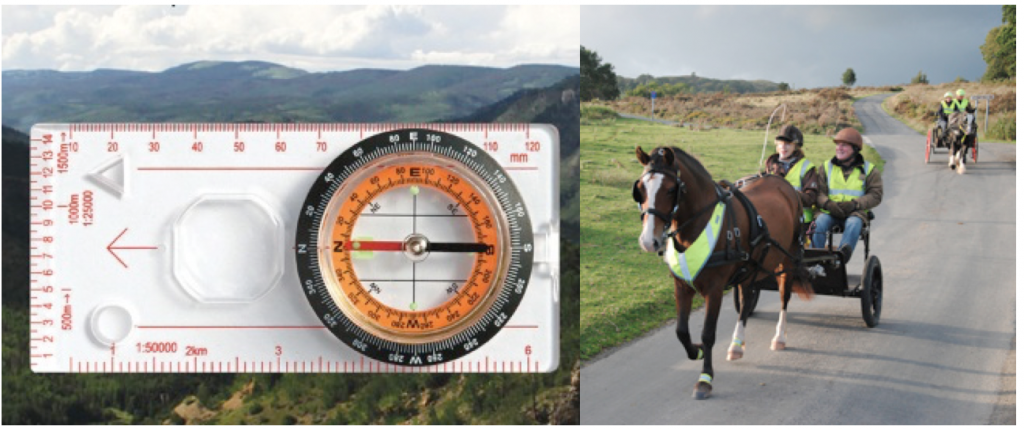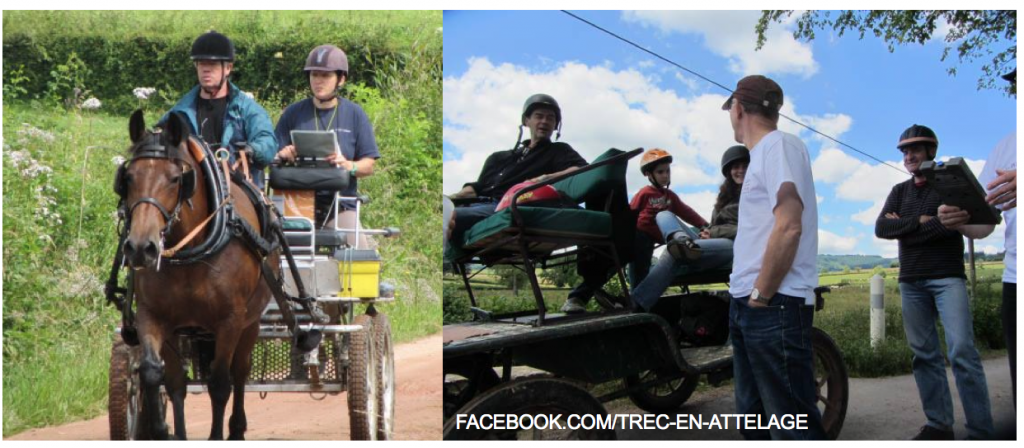
Driven Orienteering or POR (from Parcours d’Orientation et de Régularité)
Points: 240
Length of Route: Based on Driver Level
The POR phase of a TREC competition is designed to demonstrate skills need to navigate a mapped route in a time accurate manner. Drivers are judged based on accuracy of both speed and direction. Tools permitted include watch, compass, and map. No GPS allowed!
Drivers are scored based on the accuracy of both speed and direction. Map skills allow drivers to anticipate the effort of the horse and to manage his progression.
THE MAP:
TREC makes use of Topographic Maps with a scaled grid overlay. The map scale may vary depending on riding area. In international competition the scale is always 1:25,000 K.
Competition maps include the starting point, the route, and directional arrows. Checkpoints are not indicated on the map (see below).
SPEEDS:
Speeds are posted at the start, and at each stage checkpoint along the route. The goal is to travel at the posted speed until arriving at the next checkpoint. Factors that affect time include terrain, stopping to orient oneself, and getting lost. Speeds are posted in KPH.
CHECKPOINTS:
Drivers come to unmarked checkpoints along the route where their direction and or times are recorded by the course judges.

Types of checkpoints:
- Stage Checkpoints: Drivers are stopped and asked to present timecards. Checkpoint judges record time in and set time out (usually a 5 minute interval). Drivers are encouraged to make use of this time to get their bearings, water horses, take a break. If a horse appears in distress a check point judge may hold the rider for a longer period.
- Route Checkpoints: (also called control points or pass through checkpoints): These types of checkpoints simply indicate whether a driver is on the right course (or not).
- Veterinary Checks: In more challenging competitions, their may be vet checks on route to determine a horse’s ability to continue. At the end of an international level course, drivers have 30 minutes to report to the vet check after completing the route. in this case, vets determine whether they are fit to continue on to the next phase.
SCORING:
Each driver starts with 240 points from which penalty points are subtracted based on performance. Common types of penalties are listed below.
- Time penalties: There is an optimum time set for each section of the course based on distance and speed. Drivers receive 1 time penalty point per every (4) seconds over or under the optimum time for each section.
- Navigational Penalties: Entering a Checkpoint from the wrong direction (-30), Missing a Checkpoint (-50), Missing a Control / Pass Through Check Point (-X)
- Additional Navigational Tests: At higher levels, sections of the route may require navigation based on azimuths or grid coordinates. Scoring is based on the accuracy of the execution.
- Equipment Penalties: -1 point per missing item. See below.
Timecards:
Drivers carry timecards with them that are marked by the course judges. This is the official record of your ride – do not lose it!
Equipment:
In the orienteering phase drivers are required to carry specific safety equipment. Equipment may be checked at any time while on course.
Required Items include:
- Driver and Horse Identification
- Halter and Lead Rope
- High Visibility Reflective Gear / Safety Lights
- Hoof Boot or Farrier Kit (for shod horses)
- First Aid Kit for Horse & Rider
- Carriage Repair Kit
- Leather Repair Kit
Recommended items include:
- Food and Water for Horse and Driver
- Whistle
- Flash Light / Headlamp
- Weather Appropriate Clothing
- Watch / Compass / Pens
Levels:
L1-2: At the lower levels the orienteering course are shorter and speeds less demanding. Drivers may ride in groups of up to 2 carriages. Drivers may be given a map with the route already drawn in and have a chance to study the route before they start.
L3-4: At these levels the orienteering phase become more challenging in distance and speeds, and require greater map reading skill and equine fitness levels to compete successfully. Drivers report to a map room where they are given a set period of time to transcribe the route onto a blank base map. Accurately transcribing the route takes practice! At these levels, Drivers go out one carriage at a time.

No crying in the woods!
The POR Phase of a TREC Competition is often regarded as the most challenging as it requires both map skills and timing. Learning these skills is a lot of fun and helps drivers develop practical knowledge and the confidence to explore new territories with their horses and ponies!